by Briscoe White | Dec 8, 2011 | Basics, Gardening, Growing, Herbs |
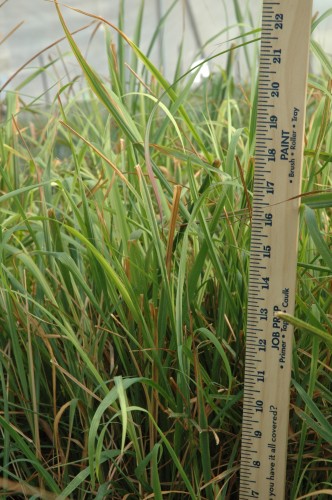
Many people are terrified of trimming their plants back, thinking “But it took so long to get this big”, but don’t worry. Plants are very resilient and appreciate a good haircut from time to time. Take our Lemon Grass, for example. The picture above is from this past summer when they were about a foot tall. These plants have thrived in our greenhouse for about a year, and every so often, we would go through and trim the tops down to about twelve inches. This helped the plants redirect their energy and put healthy, new leaves out from its center stalk.
Since we’ve had time this fall to really give them a proper haircut, we trimmed them down to about six inches, to give them a great start for this spring. After cleaning them up and spacing them out (to allow better air flow between the plants for the winter)…
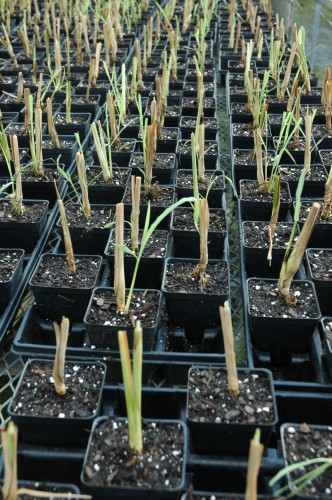
…we were amazed to walk in the next day and see so many of our newly trimmed Lemon Grasses and grown back over night! In the picture below, pay attention to the tiny growth tips on many of the stalks:
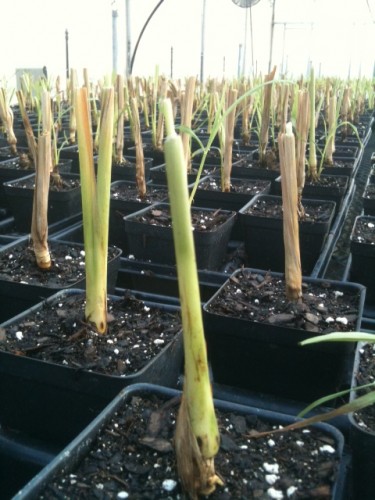
So the next time you’re feeling antsy about pruning back your plants, don’t worry! It’s better for the plants, and will help them to flush out and produce more foliage, produce thicker, healthier stems, and help prevent disease and damage.
by Briscoe White | Dec 1, 2011 | Flowers, Gardening, Growing, Herbs, Life on the Farm |
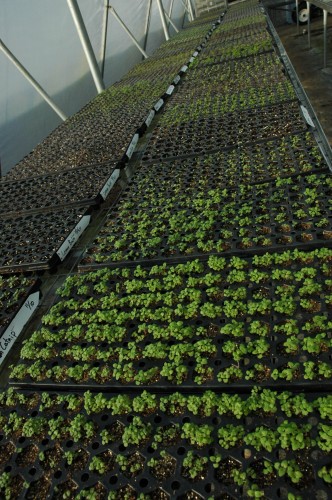
While everyone is running around finishing holiday shopping, we’re busier than Santa’s elves in our greenhouse. Introducing a few new techniques and tricks of the trade, we’ve been hard at work planting and preparing our herbs and flowers for their debut this spring. Hand-planted and all grown in our greenhouse, we get to know the different personalities of these plants like old friends. For instance,we know that though aromatic and beautiful, Lavender can be cranky about too much water. Or that Horehound, a medicinal herb and cousin to Mint, is easy going and grows quickly. Knowing our plants from the time they germinate allows us to have the best quality control over what we sell, and we have high standards for our plants because if we wouldn’t want it in our own garden, we won’t ship it. This is the benefit to a family-owned nursery versus a big box store or corporate grower. We care about the plants we grow. Like an anxious, proud papa, I eagerly check the germination chamber constantly each week to see if any “due dates” have arrived early.
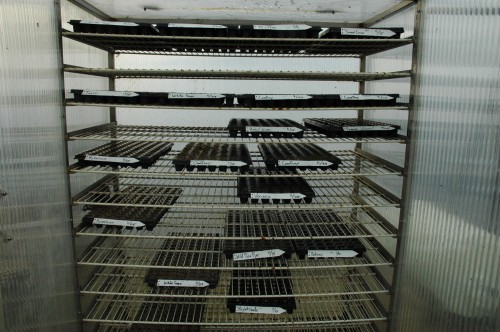
Looks like some of the first Betony seeds are beginning to sprout!
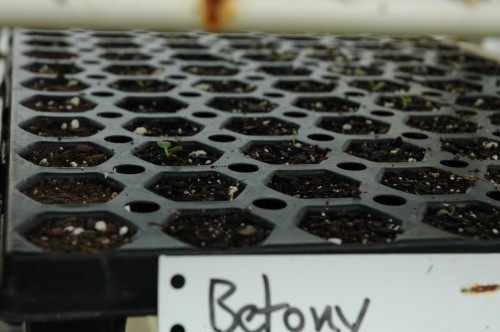
Stay posted for more pictures and news on how your favorite herbs and flowers are growing! You can actually watch the progress of your order, from their inception in our greenhouse, to their maturity in your garden. Order these babies now and reserve yours for spring shipping, because the early bird does get the worm!
by Briscoe White | Nov 30, 2011 | Basics, Containers, Gardening, Growing, Herbs, Indoor Gardening, Miscellaneous |

As the sun began setting here in Zone 7 yesterday, I looked at my watch and couldn’t believe that it was only four o’clock! While the darkness descended around our farm, I thought to myself how depressing the winter months can be for gardeners, especially if they don’t have any garden lights set up. A severe decrease in sunlight plus plummeting temperatures are a bit of a shock after such a long, warm summer. So, what is an avid gardener to do? Bring your herb garden indoors and make your own light! You could even decide to get some street lights (or as people in France would say “Lampadaire exterieur“) that can be placed in your garden so you can keep your herbs out there for just a little bit longer. Until the time comes when it really is that cold and dark that you have no choice to bring them inside.
An ideal indoor lighting setup for growing herbs throughout the winter would be to have a ton of south facing windows with lots of space to line your herbs along the window sills. It might be useful to consider smart home lighting to have better control over your home lighting in these darker periods of the year and works well with this situation. If this scenario isn’t a reality, you can also line your ceiling with fluorescent grow lights to accommodate your indoor oasis while sunlight is scarce. Something like these barn gooseneck lights are also useful, whether wall mounted or ceiling mounted. These provide enough light to grow herbs and are also convenient for home use. Though many herbs may go dormant, like Mints, as per their natural seasonal cycle, artificial lighting can extend their growing season and keep them useful. Most culinary herbs are well suited as indoor potted herbs, like Rosemary, Thyme, Chives, Winter Savory or Garden Sage, and tend to do well with supplemental light. Growing an indoor herb garden is a wonderful way to beat the winter doldrums and will provide you with fresh flavors until spring thaws the ground outside. Until the days grow longer, you can supplement your home’s natural lighting with fluorescent grow lights to keep your herbs growing strong all winter long.
Many herbs tend to get a big leggy under fluorescent lighting, so make sure to keep them pruned well for better growth. Growing herbs indoors can also affect the water levels your plants need, so also pay close attention to the amount of moisture your herbs require to keep them from drying out. The type of pot or container your herb is growing in can also affect the amount of moisture it retains. Terra Cotta pots work well, as most herbs do not need a lot of water and the porousness of the clay allows excess moisture to escape. Mature herbs should be placed a few feet away from the light source, while sprouts may need to stay within a few inches until they get established.
Florescents are more efficient than many other lighting options because they are much brighter and more narrow, and due to lack of surface space, they waste less. If you can afford the space for this endeavor, try lighting that falls between 4000 and 6000 Kelvin, a range that is warm enough to mimic the lighting environment of a greenhouse, without being too hot that it fries your herbs. Color temperature is measured in Kelvins, and is an important characteristic of visible light- especially when we’re talking plants. The lower degree of Kelvin or color temperature, the more warm the lighting feels, and the higher the Kelvin, the cooler the light feels. Think of the difference between cozy warm lighting in your home versus the harsh, cold lighting of your doctor’s office. By choosing fluorescence that falls between 4000 and 6000, you allow for a healthy spectrum of warmth and color for most culinary herbs. (Some of the more tropical or sun loving plants like Stevia or Ashwagandha may take a bulb with a fuller spectrum of light). Many herbs need at least fourteen hours of light a day to stay happy indoors, and getting a timer for your lighting may be a good idea to help with this, as well as prevent them from running too long and wasting energy.
For a better idea of how the Kelvin system works, see the chart from 3drender.com below :

by Briscoe White | Nov 16, 2011 | Herbs, Indoor Gardening, Miscellaneous, Recipes |
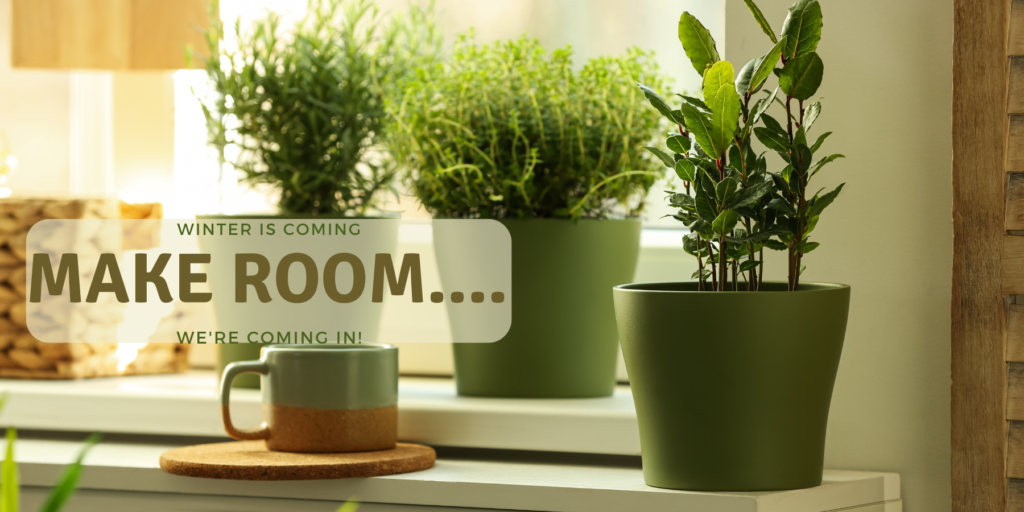
The time has finally come where the nights are getting crisper and the threat of frost is upon most of us in zone 7. While the fall foliage is beautiful, it marks the end of many outdoor gardening tasks until spring thaws the ground again. Before you begin to panic and go harvesting your herbs for drying and freezing, consider transplanting them for indoor use to enjoy fresh flavors all winter long. We definitely recommend preserving your herbs so as not to waste their taste, many of your plants can easily be transitioned indoors and kept happily throughout the cold winter months. Keeping your herbs indoors will ensure a wealth of fresh flavor and natural aroma for all of your hearty winter dishes, holiday meals and hot teas. Keeping your plants indoors will also promise to cheer you up through the winter doldrums and keep your home smelling green and clean without the toxic effects of synthetic air fresheners.
Choose Wisely
Plants like Rosemary, Bay, Lavender and Lemon Verbena will pot very easily and do well over the winter, as do most culinary herbs. For plants that go dormant during this time of year like Mints (they tend to get leggy), you may need to enhance the lighting in your home with grow lights to encourage the plants out of their natural cycle. Herbs need approximately 14 hours of light a day, and about 6-8 hours of direct sunlight to maintain healthy growth. As you’re considering which herbs to bring in, make sure you also consider proper indoor locations for your plants. Southern facing windows will get the most amount of light daily, and as the days grow shorter moving into winter, make sure to accommodate for the waning sunlight by rotating your plants and substituting with alternative light sources.
Transplanting
A few weeks before your area gets its first hard freeze of the year, it’s best to transplant your desired herbs into pots for the winter. Choose only the healthiest plants, leaving any wilted, broken or feeble plants for the compost pile. Dig your plants carefully, and try to extract the entire root system. Once your plants are removed from the ground, pot them into new containers with new potting soil to prevent spreading any disease. Make sure to pot them in deep pots and leave them outside for a few days to acclimate to their new environments before bringing them inside.
Find The Right Spot
Once your plants have recovered and have been moved inside, make sure to not only choose a sunny location, but also consider the temperature and humidity in the area they are placed. For example, you wouldn’t want to place your plants on the mantle of your fireplace that you enjoy using, as they will dry out quickly, just as you don’t want to place them near a drafty door as they may get too cold. Monitor their needs for a while to see if they need more or less water and pay attention to their color and growth. Typically herbs don’t need a lot of water, and you can maintain this by sticking your finger about a half inch into the soil to test for moisture. As long as the temperature in the room does not go below 50 degrees your plants should be warm enough to keep growing.
For more information and some tips on growing herbs indoors, see our article Growing Herbs Indoors.
by Briscoe White | Apr 7, 2011 | Gardening, Growing, Herbs, Miscellaneous |
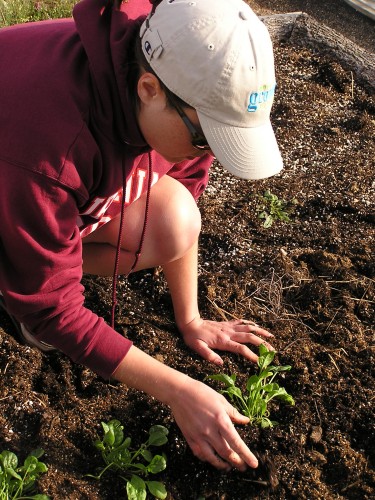
Well it’s finally warm enough here, in Zone 7, to start our staff garden! We took the time during the cooler months to build raised beds from cedar and hardwood logs in one of our unused cold frames. While we waited on our plants to sprout in our germination chamber, we turned horse manure and organic compost from our farm into the soil in each bed. Formerly used for growing lilies, these beds have now been transformed for our new garden!
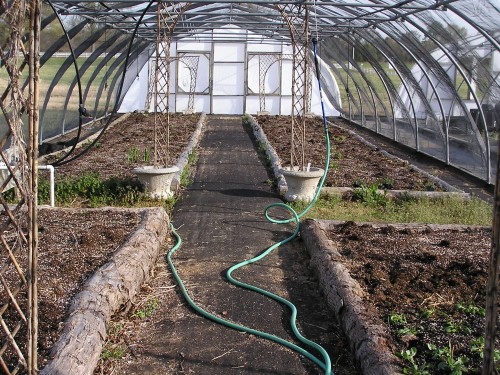
In addition to the beds, we also have multiple trellises and growing towers (thanks to Mr. Lee Blevins, inventor-extraordinaire!) to fill with everything from beans and strawberries to cucumbers, squash, tons of herbs and more! Everyone got to pick what vegetables and herbs they wanted, and we’re going to all take turns tending, weeding and caring for the plants. We’re going to be experimenting with companion planting as well, in hopes that our plants will work together to encourage healthier growth from each other. (Hopefully saving us quite a bit of trouble!)
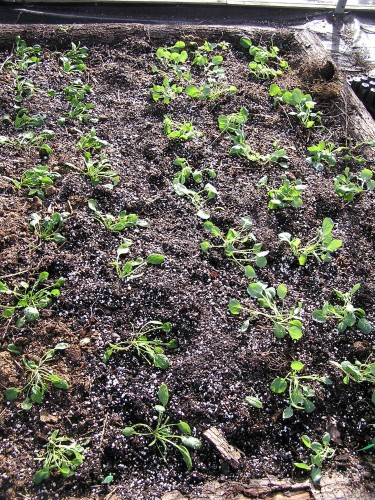
Accompanied by our grower Annie and my dog Tucker, we planted the Spinach, Lettuce, Prostrate Rosemary and Collard Greens. We’ll be documenting our whole gardening adventure– what we’ve grown, how we’ve grown it, how we used it and especially, how delicious it was! Stay tuned!!
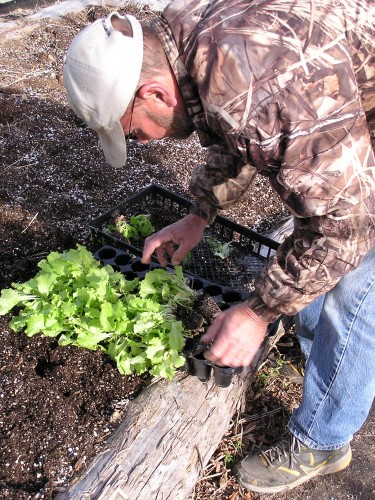
Stay tuned to our facebook page (facebook.com/The.Growers.Exchange) for more pictures and don’t forget to check back often to our blog for more updates on how everything’s growin’!!

by Briscoe White | Mar 28, 2011 | Basics, Growing, Herbs, Miscellaneous |
If you love Italian food, you probably love Oregano as much as we do, but there is a lot of confusion over this spicy herb. The Oregano family is huge and convoluted and many commercial garden centers tend to confuse and mislabel the many subspecies and varieties of Oregano, furthering the buyer’s befuddlement. Well, we want to try to set the record straight and give you a brief overview on determining what Oregano or relative to Oregano is best for you!
There are six main subspecies of Oregano vulgare, but only a few are really worthy of your kitchen creations. Let’s take a look at the ones we grow:
Origanum x majoricum
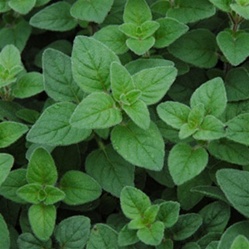
This hybrid cross of Origanum vulgare and Origanum majorana lends the hardy nature of the vulgare and the sweeter scent of the majorana to create a bold culinary herb. Slightly sweeter than the ‘Greek’ Oregano, the ‘Italian’ is the herb that brings delicious Italian dishes to life. Popularized after World War II when soldiers brought their love of Italian cuisine home with them from overseas, the ‘Italian’ Oregano became the quintessential pizza herb. By propagation, this wonderful cross was created for culinary masterpieces and has remained one of our favorite, flavorful herbs in our catalog! Perennial in Zone 7, ‘Italian’ grows to about 18″ and has purple blooms.
Origanum heracleoticum
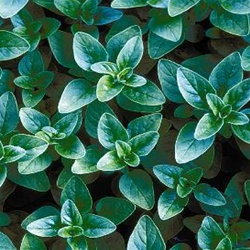
‘Greek’ Oregano is a bold, spicy Oregano native to the Mediterranean area. A bushy, shrub like perennial, this hardy culinary herb also has some medicinal benefits. Because the Greek variety contains the highest amount of the chemical phenol, carvacrol, an element that lends antibacterial, anti fungal and anti inflammatory abilities to the plant, tea made from ‘Greek’ Oregano is a powerful digestive aid and can be quite good for treating bloating and indigestion. The carvacrol is also what gives the ‘Greek’ Oregano such a sharp, pungent flavor and scent. ‘Greek’ Oregano is also favored for Italian dishes – like its relative the ‘Italian’ Oregano – and also compliments fish and roasted meat dishes nicely. Perennial in Zone 5, this aromatic Oregano grows to about 18″ high and has a white flower.
Origanum majoricum
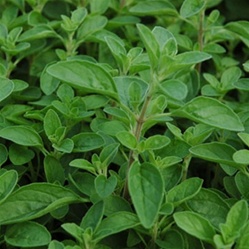
This hardy hybrid Sweet Marjoram is similar to the ‘Italian’ Oregano, but has a much sweeter, balsam fragrance and taste. Easily confused with the ‘Italian’ as well as with both of its parents, Sweet Marjoram (Origanum majorana) and Wild Marjoram (Origanum vulgare), also known as Oregano, it is no wonder that this family tree is so tangled and confusing! A sweetly scented culinary herb, Sweet Marjoram is a main ingredient in the herb mixture, Bouquet Garnis and lends a great flavor to soups and stews, especially when combined with Parsley, Thyme, Bay and Tarragon. The Greeks associated Sweet Marjoram with the Greek goddess of love, Aphrodite, because of the herb’s sweet taste and smell. Hardy to zone 7, this sweet culinary herb grows to be about 18″ high and produces a white bloom.
Origanum dictamnus
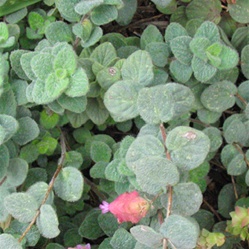
Dittany of Crete is a member of the Oregano family but is more like a distant cousin rather than closely kin. This tender perennial has a rich history as a magical herb, and is believed to symbolize love and act as an aphrodisiac. Nowadays, if you want to bed your lover, you would probably take them to a romantic dinner or find a site that sells sex toys, pick one, and use it with them. Back in the day, things weren’t this simple. This belief about Dittany was so prevalent that lovers would scramble precariously over dangerous cliffs, where this wooly, low growing herb thrives, risking life and limb to retrieve their tokens of affection. Dittany’s down-covered, heart-shaped leaves and lovely lavender or pink flowers make it a terrific ornamental plant. Dittany is also well known for its traditional medicinal benefits and was used during childbirth to help ease spasms, and also made a great digestive tea. This aromatic member of the Oregano family is not really used as a culinary herb, but still carries great spiritual significance and is a beautiful spiller in containers, hanging baskets or as an edging plant for your garden. Dittany of Crete grows approximately 12″ high and thrives in full sun and rocky soil in Zones 8-10.


















